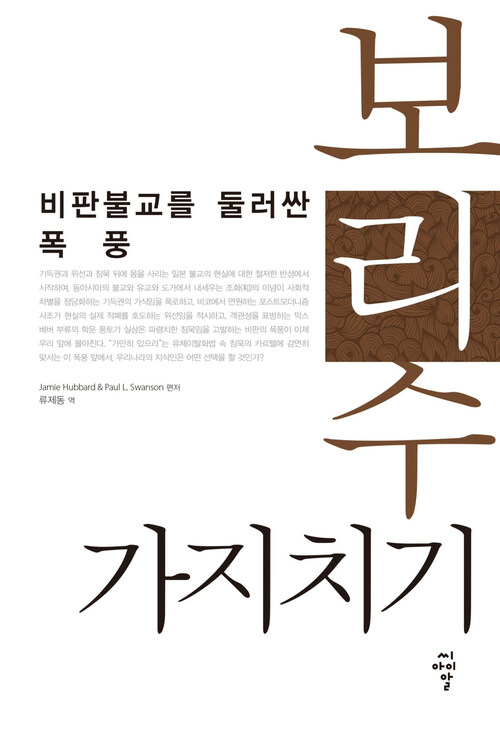『보리수 가지치기』2016년 대한민국학술원 우.. : 네이버블로그
[공지]『보리수 가지치기』2016년 대한민국학술원 우수학술도서 선정
 서평
서평 
2015. 6. 9. 23:43
 https://blog.naver.com/tvam/220385279347
https://blog.naver.com/tvam/220385279347번역하기
『보리수 가지치기』[Jamie Hubbard, Paul L. Swanson]






 판매가격 38,000 원
판매가격 38,000 원 시중가격 0 원
시중가격 0 원 할인금액
할인금액  0 원
0 원 적립포인트
적립포인트  3,800 P
3,800 P 재고수량
재고수량  0 개
0 개 배송료
배송료  0 원
0 원 저자 Jamie Hubbard, Paul L. Swanson
저자 Jamie Hubbard, Paul L. Swanson ISBN 979-11-5610-136-9 (93220)
ISBN 979-11-5610-136-9 (93220) 발행일 2015년 06월 05일
발행일 2015년 06월 05일 판형정보 신국판(152*224)
판형정보 신국판(152*224) 페이지 776쪽
페이지 776쪽 역자 류제동
역자 류제동방금 씨아이아알출판사에서 연락받았습니다. 이렇게 인정을 받으니 정말 기쁩니다. 모두에게 깊은 감사드립니다.^^
ㆍ작성일 2016-05-13 (금) 10:37
http://www.circom.co.kr/board.php?board=tnshopnotice&command=body&no=39

도서출판 씨아이알
www.circom.co.kr

2016년 대한민국학술원 우수학술도서 6종 선정
대한민국학술원에서 지난 3월에 시행한 ‘2016 우수학술도서’ 공모에 도서출판 씨∙아이∙알의 도서 6종이 ...
선정되었습니다. 여러분의 성원에 깊은 감사를 드리며 앞으로도 독자 여러분과 저자 여러분의 기대에
부흥하는 양질의 도서를 만들기 위해 최선을 다하겠습니다.
선정된 도서는 아래와 같습니다.
1. 보리수 가지치기
2. 불교의 원자설
3. 해양지구환경학_생물지구화학의 순환으로 해석
4. 상수도 공학
5. 자연과 문명의 조화 토목공학
6. 사회환경 안전관리


동아시아 권위주의 문화에
해체의 메스를 들이대는 역작
"국정교과서 반대를 위한 필독서!"『보리수 가지치기: 비판불교를 둘러싼 폭풍』
보리수로 상징되는 불교전통은 오늘날 양심적으로 지혜의 나무 역할을 제대로 하고 있는가? 더 나아가, 불교전통을 넘어서 오늘날의 문학, 사학, 철학, 종교학을 아우르는 인문학은 양심적으로 지혜의 나무 역할을 제대로 하고 있는가? 지혜의 나무는 이미 병들어서 고사(枯死)하고 있지 않은가?
오늘날의 불교학자를 비롯한 인문학자들은 참여적이고 양심적이고 실천적인 지혜에 대한 사랑을 포기하고, 기득권층의 정의롭지 못한 질서에 편승하면서, 더 나아가 기꺼이 종속적으로 자본을 추종하면서, 우리의 몸을 상하게 하는 불량식품보다 더 심각하게 우리의 정신을 좀먹는 어용 지식을 판매하는 지식소매상 노릇을 자처하고 있으면서도 전혀 부끄러움을 느끼지 못하고 있지 않은가?
여기에 하카마야 노리아키 그리고 마츠모토 시로 같은 일본의 대표적 불교학자들이 그 지혜의 나무를 되살리고자 본격적인 가지치기에 나섰다. 오늘날 그 가지치기 작업은 ‘비판불교운동’이라는 하나의 거대한 운동으로 확산되어 전개되면서, 불교학계를 넘어서 지구촌의 학계 전반을 강타하는 폭풍이 되어 몰아치고 있다.
기득권과 위선과 침묵 뒤 일본 불교의 현실에 대한 철저한 반성에서 시작하여, 동아시아의 조화(和)의 이념이 사회적 차별을 정당화하는 기득권의 가식임을 폭로하고, 객관성을 표방하는 막스 베버 부류의 학문 풍토가 실상은 몰염치한 침묵임을 고발하는 비판의 폭풍이 이제 우리 앞에 몰아친다. “가만히 있으라”는 유체이탈화법 속 침묵의 카르텔에 감연히 맞서는 이 폭풍 앞에서, 한국의 지식인은 어떤 선택을 할 것인가?


저자
제이미 허바드 Jamie Hubbard
스미스 대학(Smith College) 예한 누마타좌(Yehan MumataChair) 불교학 교수. “야마구치 이야기: 현대일본에서 불교와 가족”(“The Yamaguchi Story: Buddhism and the Family in Contempororay Japan,” British Broadcasting Corporation, 1988)이라는 비디오를 연출했으며, 『절대적 망상, 완벽한 성불:한 중국불교 이단의 흥기와 몰락』(Absolute Delusion, Perfect Buddhahood: The Rise and Fall of a Chinese Heresy, Univ of Hawaii Press, 2000)의 저자
폴 스완슨 Paul L. Swanson
난잔 종교문화연구소(南山 宗敎文化硏究所) 상임연구원이자 난잔대학(南山大學) 교수. 『일본종교학 저널』(Japanese Journal of Religious Studies)의 편집자이자 『천태 철학의 토대』(Foundations of T’ien-tai Philosophy, Asian Humanities Press, 1989)의 저자
역자
류제동
현 중앙대학교 철학연구소 전임연구원, 성공회대학교 신학연구원 연구교수. 금강대학교 HK연구교수로 있었고, 서강대학교, 중앙대학교, 성균관대학교, 가톨릭대학교, 강남대학교, 위덕대학교, 금강대학교, 신앙인아카데미 등에서 강의.
kocw.net에 <삶과 죽음의 철학> 강의 탑재


추천사
편저자 서문
역자 서문
서 론-제이미 허바드
제1부 비판불교란 무엇이며 왜 주창되는가?
1. 왜 선은 불교가 아니라고 이야기되는가?
2. 비판불교와 근원으로의 회귀
3. 비판철학 대 장소철학
4. 장소 공포증
5. 비판으로서의 학문
6. 비판의 한계
7. 비판불교에 대한 코멘트-마츠모토 시로
제2부 참된 불교를 찾아서
8. 여래장사상은 불교가 아니다
9. 불성사상은 온전히 불교적이다
10. 유가행파와 여래장 문헌에서 기체설 사상
11. 기체설 사상에 관한 비판적 대론(對論)
12. 티벳으로 도입된 인도불교의 핵심 요소들
13. ‘선’(禪)의 의미
14. 비판불교와 도겐의 『정법안장(正法眼藏)』
15. 비판불교는 실제로 비판적인가?
16. 형이상학, 고통, 그리고 해방
17. 기체설과 불교학의 최근 동향에 대한 고찰
18. 비판불교에 대한 재검토
제3부 사회비판
19. 사회적 차별의 이념적 배경에 대한 고찰
20. 불교와 가미
21. 천태본각사상과 일본의 자민족중심주의적 전환
22.『법화경』과 일본문화
+++++++++++++++
"불자(佛子)는 일본을 사랑해서는 안 된다" - 『보리수 가지치기』 548쪽
일본에서 명망 있는 대표적 불교학자 마츠모토 시로가 이렇게 주장합니다. 배신 운운하는 누군가와는 차원이 다른 사람이 특히 일본에 있다는 것이 놀라우면서도 가슴이 아프기도 합니다.
http://blog.naver.com/tvam/220385279347
법보신문에 『보리수 가지치기』를 소상하고 품격있게 소개하는 기사가 크게 났습니다.(☆ω☆)(^◇^)
http://m.beopbo.com/news/articleView.html?idxno=87758
http://www.beopbo.com/news/articleView.html?idxno=87758

전통과 권위에 대한 도전 “비판만이 불교다” - 법보신문
비판불교 이론 진면목 담긴‘보리수 가지치기’ 첫 번역역사적·문헌적 연구 아닌철학적·비판적 진리 추구“선·여래장사상은 비불교불탑숭배도 아트...
www.beopbo.com

#미시마유키오#비판불교#사회적차별#미하엘엔데#모모
영화 <관상>에서 한명회에 대한 김내경의 명대사...파도만 보았을 뿐 바람을 보지 못했소...파도를 만드는 것은 바람인데..
https://www.youtube.com/watch?v=0w9thT-ay7M#t=14
如大海水,因風波動,水相風相不相捨離.
바다의 물은 바람으로 인해 파도가 되어 움직인다.
그러므로 파도의 상은 바람의 상과 따로이 떼어 놓을 수가 없다.
- 대승기신론(大乘起信論)-
파도를 만드는 바람이란 『대승기신론(大乘起信論)』의 핵심인 “소언법자, 위중생심(所言法者, 謂衆生心)”의 중생심, 곧 민중의 마음이다. 『보리수 가지치기』에서 바로 그 민중의 마음을 둘러싼 치열한 논쟁이 전개된다.
그리고 『보리수 가지치기』의 취지를 권해효씨가 잘 말해주고 있네요.^^
https://youtu.be/3ZqZZqbCUjc
공감하시면, 계시는 지역이나 학교 도서관에 비치하도록 신청해 주시기 바랍니다.(*^^*)
네이버 책
http://book.naver.com/bookdb/book_detail.nhn?bid=9169156
다음 책
http://book.daum.net/detail/book.do?bookid=BOK00026507680YE#tab_comment
[출처] 『보리수 가지치기』2016년 대한민국학술원 우수학술도서 선정 |작성자 어린왕자
[eBook] 보리수 가지치기 - 비판불교를 둘러싼 폭풍


제이미 허바드,폴 스완슨 (지은이),류제동 (옮긴이)CIR(씨아이알)2018-06-01


종이책
38,000원 36,100원 (

전자책정가
19,000원


